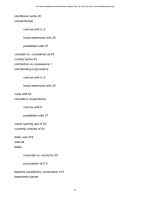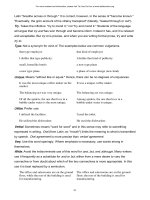the elements of design line colour tone shape space
Bạn đang xem bản rút gọn của tài liệu. Xem và tải ngay bản đầy đủ của tài liệu tại đây (50.85 KB, 16 trang )
This essay explains in detail, line, colour, tone, shape, space ect excellent.
Line
Line is the most direct way of making a mark, lines define form and shape. Lines do
not occur in nature. They are simply used to translate a form into something we can
recognise on paper. The outline just symbolises the object we represent.
- Combinations of line can be used to represent structure and movement.
- Line can be used to create the sensation of movement.
- The artist can communicate feelings by using line expressively. Different lines
encourage this.
Line Types
Contour - Line which are brief descriptions of an object.
Calligraphic - Captures the expressive qualities of an object, quick flowing marks.
Tonal - Represents shapes, form and textures in objects
Visual - Represents texture
Tactile - Drawings as themselves can be textile
Line Direction
Circles, curved lines - movement , progression.
Vertical - Elevation, formality.
Horizontal - Intimacy, restful and peaceful.
Moderately curved - Harmony, graceful.
Line In Relation To Principals.
Variety - Combinations of contrasting lines create variety , long, short, zig zag and
horizontal
Repetition Of Line - Harmony, balance.
- Balance, common groupings of line and textures.
- Harmony, lines and textures flow together in unified direction and
corresponding rhythm.
Combinations of particular lines can also create disharmony and disunification.
Line Exercise
1.Draw three drawings analising the different types of line that are used.
2. Find Three artists , describe and discuss the types of lines and textures they have
used.
e.g. Textural - Susan Norrie
Movement - Brett Whitely
Geometrical - Geoff Smart
Texture.
- Texture is how the surface of an object feels to touch. In sculpture Real Texture is
an element in painting texture is simulated.
- Different lines can create textures,
Converging Lines
Contrasting lines and marks
Repetition of marks
- How does texture effect the design qualities and principals of an art work.
1. Contrasting textures can create form.
2. Highlights focal points
3. Textures can produce rhythm and movement.
4. Common groupings of textures can produce balance and variety.
5. Textures flowing together in common direction can produce unity.
6. Textures can establish these qualities and feelings associated with them
The surface area of any art work is very important. Two dimensional art relies almost
completely on there surface qualities to interest and attract.
Sculptors also pay close attention to the surface qualities of their materials and the
textures they create.
Textures are created by grouping contrasting lines, colours, brushstrokes, broken
colours, scratches and smooth colours.
Textural Exercise.
Take rubbings from interesting textures,
- Use different mediums.
- Take this selection of rubbings and form a composition.
- Cut out an area of the textures.
- The area that you have cut out, simulate these back into the composition.
Colour
Complementary colours are totally unrelated and opposites in the colour wheel. They
form the greatest contrast and when used together they bring out each others fullest
intensity. e.g. Red / Green, Blue / Orange, Yellow / Purple.
Harmonious colours also called Analogus are adjacent in the circle. They have at least
one common colour. e.g. Yellow / Orange / Red ( Common colour is Yellow )
- The use of these two types of colours can create a purposeful and meaningful
expression within an at work.
Complementary colours can be use in such a manner to establish harmony, peace and
other such emotions
What must be remembered is that this is not in essence a Rule. It is very dependent on
what colours are used and how. e.g The use of Reds and oranges may not show peace
but may express for example an Arid Barren Land.
Primary Colours.
Yellow, Red and Blue.
Secondary Colours.
Mixed from a combination of primary colours.
Tertiary Colours.
Combination of Primary and secondary and sometimes other tertiary
- Too many secondary colours can create a dull muddy undesirable colour
Hue: The name of the colour.
Value: Refers to the lightness or darkness of a colour
High value : Light ( cool )
Low Value : Dull.
Intensity : Refers to the brightness or dullness of a colour.
High Intensity : Bright
Low Intensity : Dull
Local Colour: Is the actual colour of objects. e.g. Yellow is the colour of Lemon.
Monochromatic : When colour arrangement is made with one colour with shades and
tints of
that colour.
Dominant Colour : When one colour in a composition, with its shades that are largely
used.
Achromatics : Black and White and the mixture of the two. Greys are not colours.
They are
called Achromatics.
Lighter and Darker colours.
By adding the neutral colours, black and white you can make various tints and shades.
- Adding white is called a " tint. "
- Adding black is called a " Shade "
An important compositional aspect of colour is that shades tend to recede and tints
project themselves when placed against each other.
Contrasting colours in this aspect can create focal points and make certain images
more dominant etc.
Biological Aspects Of Colour.
Certian colours have the power to evoke emotional responses in the viewer.
Warm colours - simulate.
Cool colours - relax.
Warm colours - come forward.
Cool colours - recede.
Broken colour - This is where one colour is of another colour but the colour can be
seen in sparkles impressionists.
Tone.
Tone is very important in drawing. It makes things look real and 3-D. Tone is the
values of light and darkness, by light falling on a object.
Every object has tone because tone is created by light.
When drawing a still life the whole object must be toned.
- You must start with light
- Build up tones until you have correct value.
- You must have total range and contrast in tonal values.
Drawing.
It can be seen as representing a set of composition.
1. Proportion and scale - Size and shapes of objects
- Reference point of the objects
- Use these points to analise how big you should draw the other
. object
2. Angles how objects lead from the drawer, compare angles of other objects
- Circular tops and bottoms must be the same.
3. Space - The distance between objects.
- Look more at what you are drawing than at the page.
- Look at the still life for several minutes.
- Do some quick analytical drawings.
Shape.
There are many different types of shapes. Shapes can be enclosed by a line, but
shapes can also be created without lines. Shapes can be geometric or organic.
Organic shapes remind us of the natural world in which objects are usually irregular
and constantly changing. They are usually curved and undulating.
Geometric shapes remind us of the precision of man - made or mechanical objects.
They are usually rectilinear or straight edged.
Space
Actual space this refers to the actual space and distance existing between images and
forms.
Pictorial Space.
This is the illuseionary space that we see in 2D work. This can vary from a flat
patterned surface to the illusion of a deep space as in a landscape.
Pictorial space mimics, using spatial devices, the space in the natural environment.
Tonal devices create form, perspective overlapping of images . Depth of field -
foreground, middle and back . Field object appears larger if they are close.
Spacial relationships - Matisse was interested in spacial relationships that colours and
space made the design aesthetically pleasing composition arranging shapes and space.
Mass
This can be categorized into geometric, natural, abstract, and non objective. Mass of
an object is the size, weight, height, breadth and depth.
Geometrric Shapes.
Represent solidity and restfulness. A cone can represent a thrusting mass and this can
create a dynamic composition.
Natural Masses.
These are such forms as the human forms. Many sculptors use such forms as e.g
Henry Moore, He explored the mass of the female figure and its curved majestic
nature.
Abstract Masses.
Used extensively in modern sculpture exploring the pure essence of natural and
geometric masses, and there interaction with other enviroments. These masses evoke
thought , feelings and tensions - seeking out the purest form of the subject.
Non Objective Masses.
They refer to no specific recognisable forms. Doesn't resemble anything known to
you.
Masses And Shapes.
The Cube : Most visually stable.
The Sphere : Implies movement and rolling.
The pyramid : Represents solidity and stresses move out from the tip to the solid base.
The Cylinder : Harmonious mass and solid.









